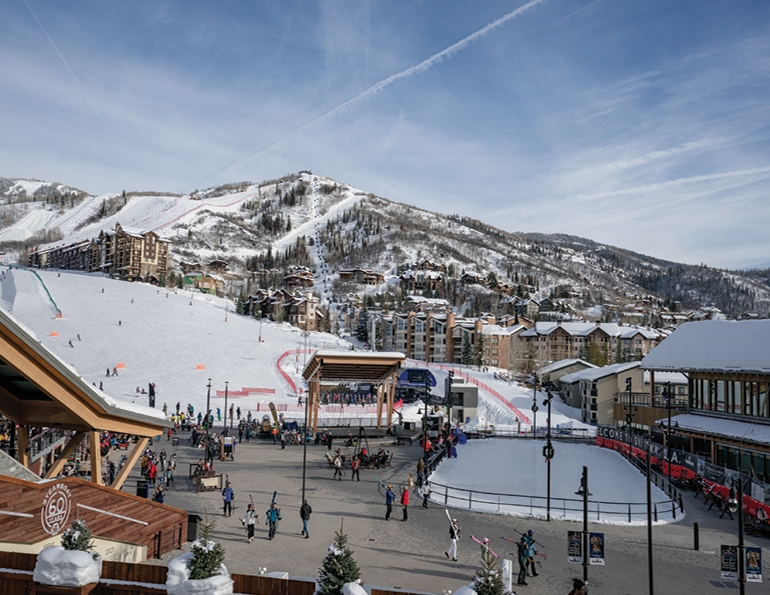While owners and operators have long been familiar with determining the best “bang for the buck” for their capital expenditures, today the scope, scale, and complexity of decision-making extends beyond the familiar investments and expectations for return.
Strategic investments are now more likely to take the long view and include a return that goes beyond the more direct ROI (return on investment) math found in a 5- to 10-year proforma, which is to say beyond the expectation of a direct return within a traditional timeframe.
These investments also consider another ROI: “retention of interest,” i.e., the broader secondary economic impacts that may be difficult to track in traditional modeling. Think: retaining/gaining interest and market share; attracting development partnerships; increasing the overall value proposition (and $ per visit); and, in general, setting up for future success.
Our industry has long been a place for “patient capital”—investments with a long return horizon—and that is becoming more pronounced as the industry matures and resorts become a little long in the tooth, thus in greater need of new investment. Here, we’ll look at the strategic thinking of three mountain destinations making significant investments with “retention of interest” in mind, and the metrics they are using to measure success.
STEAMBOAT: FULL STEAM AHEAD
The “Full Steam Ahead” initiative at Steamboat, Colo.—a more than $200 million multi-faceted project—shows many examples of strategic thinking. Built on the strong foundation of the Steamboat reputation, community, and brand, Full Steam Ahead reaches beyond short-term thinking to expand the scope, broaden the audience, lengthen the seasonality, and streamline resort operations.
Perspective shift. The project transcends the scale of traditional, operations-oriented investment thinking. Rob Perlman, resort president and COO, notes this was a critical perspective shift. “One of our biggest challenges at the beginning was transitioning from the ‘yes, but…’ mentality born from the realities and challenges of day-to-day operations to the ‘yes, and we’ll figure it out’ transformative thinking that is inherent to a long-term vision,” he explains.
This transition from a traditional work-with-what-we-have operations mode was not without challenge. But with the help of the development team at Steamboat’s ownership group, Alterra Mountain Company, and the resort’s real estate development partner, East West Partners, Steamboat began to connect the dots between solving its long-recognized challenges and seizing transformational opportunities.
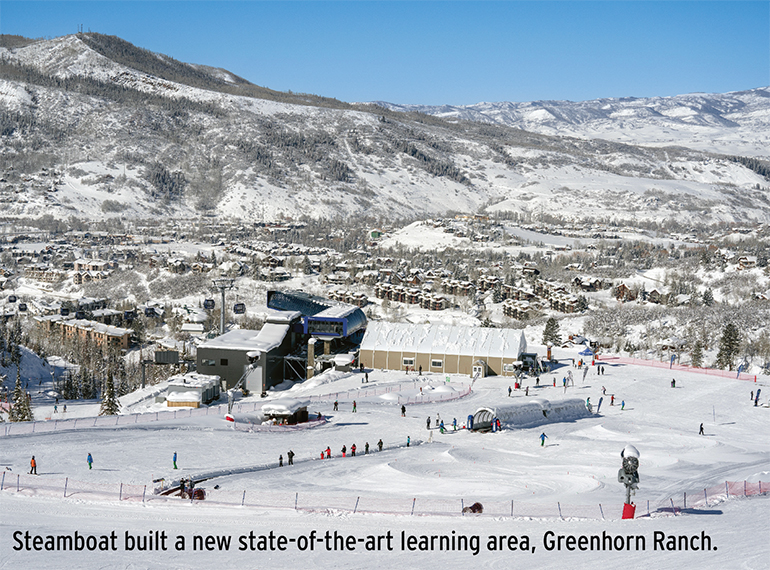
The team relied on its guest survey data as supporting evidence that aided in the decision-making. Low scores related to beginning-of-day access, activity in the base, learn-to-ski, and expert terrain informed the development plan and investment decisions. Much of that resulting vision is now in operation or scheduled for construction this summer.
Projects that cover all bases. The upgrading and expansion of the mountain covers all bases, targeting both ends of the ability-level spectrum, the entire ski day, and all seasons.
The new Greenhorn Ranch provides a state-of-the-art learning area for beginners, while the Mahogany Ridge expansion adds 650 acres of advanced/expert terrain that will make Steamboat the second largest resort in Colorado.
The Wild Blue Gondola, a two-stage gondola transporting visitors from the base to the Greenhorn Ranch mid-station or to the top of Sunshine Peak, elevates the out-of-base experience for all guests. Coupled with enhanced snowmaking for Greenhorn Ranch and Sunshine Peak area terrain, the gondola also ensures access to reliable conditions even in the early/late season. And a reconfigured base area snowfront vastly improves access onto and egress off of the mountain as well.
Perlman notes the importance of focusing the base area improvements on the key beginning- and end-of-day experiences for guests, and the interconnectivity of “getting [guests] out in the morning and keeping them here at the end of the day.”
The new “heart of Steamboat.” Thus evolved the centerpiece of the project: the transformation of the base area. Steamboat is somewhat unique for its size, as the entire mountain is accessed through one base area portal. Demand for space in this area has always been at a premium and reconciling some of the old infrastructure with future growth created challenging decision-making.
“We realized that to activate the base area, improve the experience of getting people on and off the mountain, and provide a best-in-class beginner experience, we needed to remove the old gondola building and liberate the plaza,” says Perlman. The building was removed, lifts reconfigured, and beginners relocated to Greenhorn Ranch.
The new Steamboat Square now features something for everyone, 24/7/365, such as the Skeeter’s ice rink/event lawn, the Steamboat Stage performance area, and the Range Food & Drink Hall.
While the on-mountain and base area projects create significant opportunities for ROI in both the near- and long-term, these transformational projects also create an appealing development opportunity. East West Partners is breaking ground on its first project “The Amble,” a 44-unit condo development, this summer. This first project and those planned to follow harness the “power of place” being created by Full Steam Ahead, expanding the bed base with the understanding that such a partnership between resort and developer will create memorable experiences that attract destination visits and foster repeat visitation.
Many of the on-mountain and base area projects may be viewed from the traditional perspective of ROI—projects that increase the appeal for a wider audience and improve the on-mountain experience typically come with the expectation of increased visitation, revenue, and yield. It’s an important part of the equation, of course. Collectively, however, the Full Steam Ahead projects are also an example of playing for the longer-term “retention of interest” return—an investment in maintaining Steamboat’s relevance in the marketplace for years to come.
TREMBLANT: “LARGER THAN LIFT” EXPERIENCES
The redevelopment of Quebec’s iconic Tremblant resort 30 years ago was one of the first—and still one of the best—examples of the modern-day, purpose-built, mountain resort village.
Tremblant has it all: a quaint pedestrian village full of shops, restaurants, and galleries with upper-level accommodations that keep overnight guests close to the action; a convenient “Cabriolet” walk-on gondola that whisks day users from the on-the-fringes parking to the mountain’s front door; pleasant “eddies” of greenspace for quiet contemplation; lively plazas that ebb and flow with the seasonal calendar of events; and convenient understructure parking.
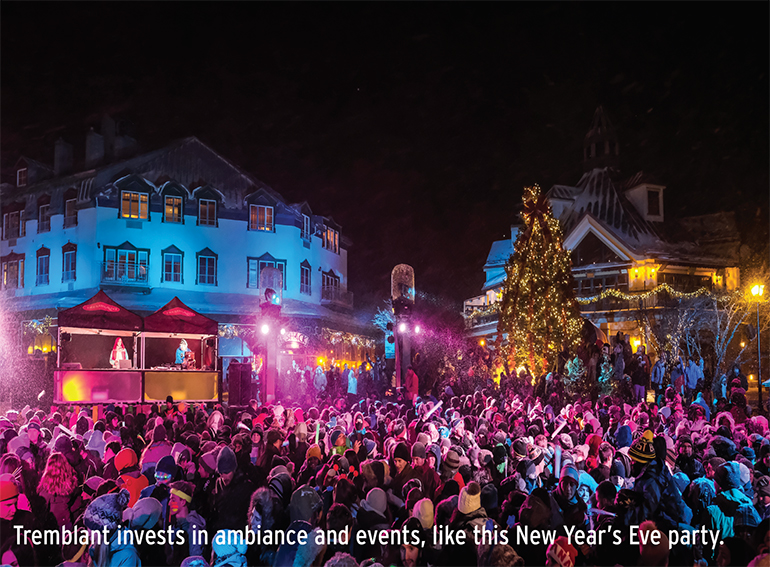
The village—a collection of independent businesses tied together by a unique membership association—offers a holistic experience under a united brand. There is never a question, wherever you are in the village or on the mountain, you are at Tremblant.
Behind-the-scenes support structure. Tremblant is, in a word, alive. It is the intentional investment in a behind-the-scenes support structure that continues to make this magic happen.
Thirty years ago, the initial vision for a united Tremblant included the creation of—and continued investment in—a resort-wide organization focused on maintaining the magic of “place”: the Tremblant Resort Association (TRA).
The TRA is a non-profit of more than 3,200 members, including Station Mont Tremblant, the mountain operation. The group’s mission, vision, mandates, and values are all laser-focused on delivering unique, memorable, “larger than lift” experiences in support of a mutually beneficial goal: supporting sustainable development of the resort and maintaining its world-class reputation.
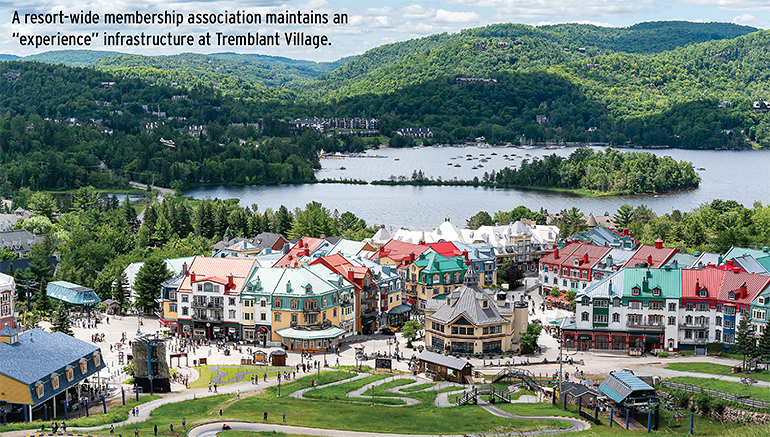
Its work is funded by a resort-wide royalty and membership fee, and the TRA is committed to an attention to detail that yields undeniably positive, yet hard-to-quantify benefits to the Tremblant experience: the creation and maintenance of common “experience” infrastructure (pathways and trails, public art, play structures, outdoor spaces/parks); year-round programs and events that activate the resort throughout every season; and special touches that build ambience, such as lights, music, and eye-catching flowers. It is the ultimate investment toward “retention of interest.”
The TRA provides and maintains the connective tissue of Tremblant. It isn’t the purview of any one owner/operator (nor could any one group afford the up-front capital or ongoing maintenance and operational costs), but the results contribute to everyone’s bottom line.
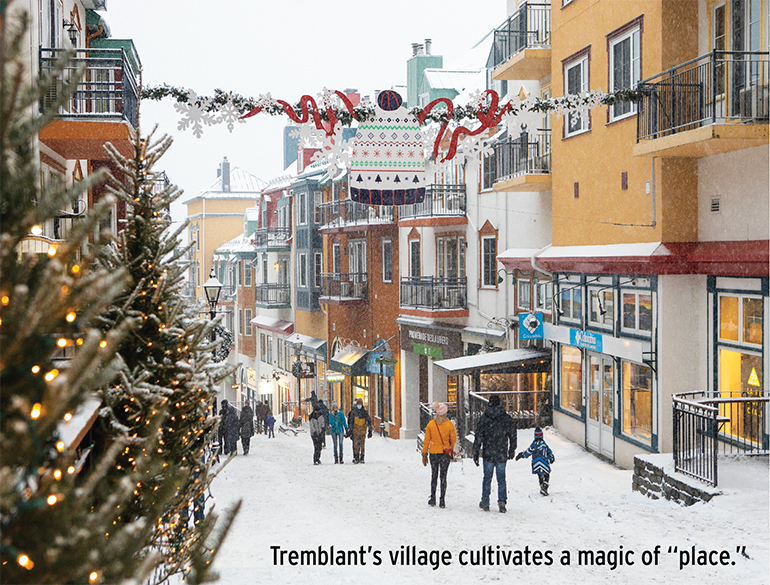
“The excellent collaboration between Station Mont Tremblant and the resort association makes it possible to align the mountain and village experience,” says Patrice Malo, president and COO of Station Mont Tremblant. “Tremblant is thus distinguished by its unique and integrated character and its contagious ‘joie de vivre.’”
Programs and events. The calendar of programs and events drives year-round visitation, which has an obvious connection to revenue and yield, but also creates an attractive venue for the partnerships that make up the village: lodging properties, retail outlets, galleries, and restaurants.
This perpetual “feeding” of partnerships also feeds the media machine. “The resort association deploys several marketing campaigns to attract destination guests staying overnight,” says Annique Aird, VP of marketing and sales for the ski area. “By sharing the Tremblant brand, we are able to unite our marketing efforts, creating greater benefits for all members.”
And, that investment in ambience? Never underestimate the power of summer flowers, fairy lights, or ice sculptures. The attractiveness of Tremblant’s village setting encourages visitors to linger, to stay longer, spend more, and feel good while doing so.
Put it all together and the successful ongoing ROIs are clear. Tremblant attracts about two million visitors annually, nearly equally split between winter and summer.
BOUSQUET: THE WIDER RECREATION FRAMEWORK
Bousquet, Mass., is one of the oldest continuously operating ski areas in the country, serving generations of local Pittsfield and Berkshire County families. But when Mill Town Capital, a community investment company based in Pittsfield, took ownership of the operation in 2020, the area was showing its age. Three years later, as part of Mill Town Capital’s larger regional economic development strategy, Bousquet’s future is looking up.
New base lodge. One of the first moves was to build a new 17,000-square-foot base lodge. Like many older lodges in the Northeast, Bousquet’s was tired and not delivering a desirable guest experience. Replacing it presented both near- and long-term benefits. For one, it provided much-needed excitement and media buzz to re-engage the area’s waning audience. Its new F&B venues significantly raised the bar of the area’s previous dining experience. And its restaurant and banquet venue created additional year-round revenue streams.
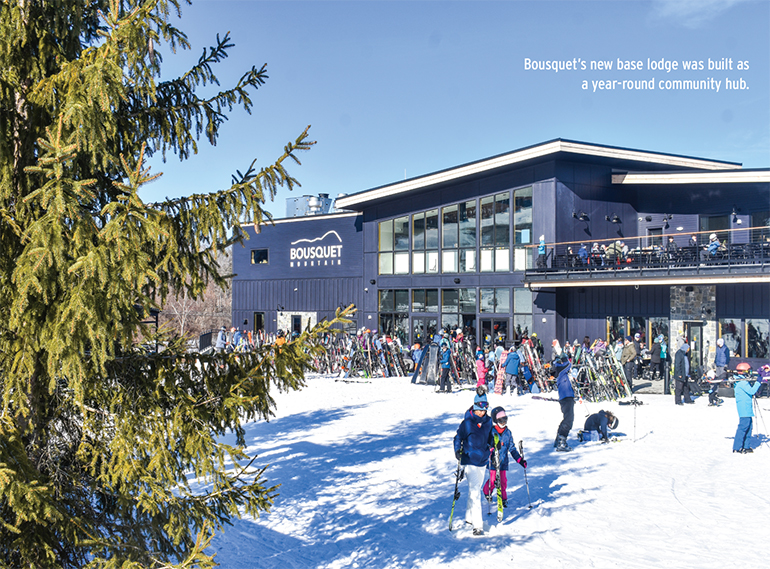
“Our goal with the lodge is to flip the switch after the ski season so that it becomes a year-round community asset, a vibrant hub to the larger recreational resource,” says Tim Burke, CEO of Mill Town Capital. The team is considering what expanding into summer recreation means for Bousquet, which currently offers just hiking trails outside of winter.
Bigger picture. Improving the F&B experience and expanding to multi-season operations are not new concepts to our industry, and both are firmly rooted in traditional investment decision-making. While these capital improvements contribute to a direct ROI, they also get Bousquet back on the consumer’s map, setting the operation up for longer-term success, aka, “retention of interest.”
Yet for Mill Town, the longer-term strategy goes further than just the ski area and connects to a bigger-picture social and economic contribution to the community. As with Mill Town’s larger portfolio—which includes a local overnight camp and an indoor sports facility—the group is committed to “cultivating and growing the assets we have, because the sum of the parts is greater than those of the individual,” says Burke.
Bousquet is an invaluable recreational resource to the Pittsfield community and the region as a whole. This value, coupled with its location within the Berkshire County outdoor recreation framework, was not lost on its new owners. The critical role of outdoor recreation in the larger economic development framework of the region was identified in the 2020 Outdoor Recreation Plan for Berkshire County.
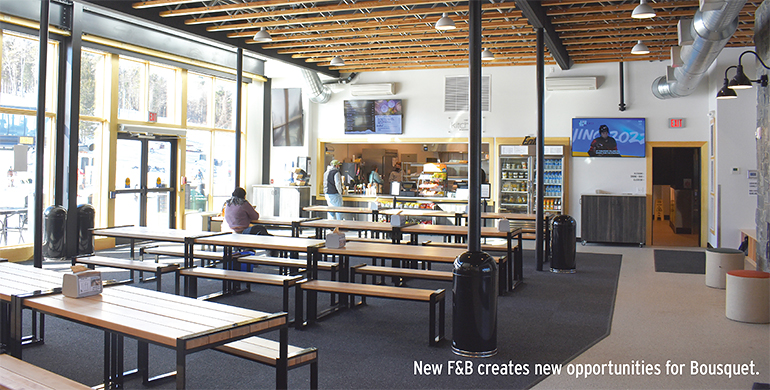
Year-round, region-wide potential. “Providing skiing to locals is key, but from a year-round, regional perspective there is so much more potential,” says Burke.
Bousquet will contribute to and benefit from Berkshire County’s regional outdoor recreation economy. From a business perspective, this will drive year-round visitation and revenue. From a community perspective, it contributes to quality of life and economic development. And from an ownership perspective, Mill Town understands that the overall health of the community and of the ski area are connected.
“For us, investment success is defined by the sustainability of Bousquet’s operation, and its ability to be here for a long time,” Burke says.
MEASURING SUCCESS
A longer-term “retention of interest” investment is not made in the absence of the direct math of more immediate-term ROI. As illustrated, retention-of-interest strategies include expectations for near-term benefits as well as investment in the future. That said, in addition to tracking the ongoing financial gains of nearer-term projects, there are other metrics for determining the success of longer-term, bigger-picture investments.
Listen to the community. “We continually watch how the community reacts to what we’re doing at Bousquet,” says Burke. “We note rates of season pass sales, returning passholders, race program participants. We get granular with these results.” NPS scores and other guest survey data can also be valuable metrics.
Sometimes, success is measured through the absence of failure. For Mill Town Capital, this reality was top of mind when it purchased Bousquet. The viability of the resort is tied to its ability to remain relevant to visitors and its community, a sentiment TRA general manager Cristina Romero echoes in a letter to members published on the Tremblant website.
“Tremblant will only continue to prosper if we offer our guests a total experience they are not likely to find anywhere else,” she writes. “As a member of the TRA, you become a partner in the development of Tremblant, supporting our primary objective, which is to foster the development and operation of a four-season resort of international scope.”
Regardless of the scope or scale of your operation, one thing remains true: as our ski areas and resorts mature and the complexity of our competitive marketplace evolves, owners and operators will be faced with strategic investment decisions that transcend the timeframe of traditional modeling. Embracing the complexities of investing in “retention of interest” offers potential for the greatest return: a sustainable future for your area, the industry, and the memorable experiences we offer.





